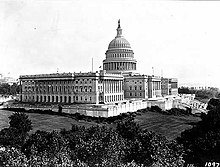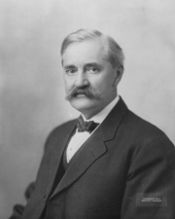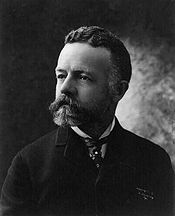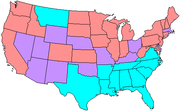67th United States Congress
| 67th United States Congress | |
|---|---|
66th ← → 68th | |
 United States Capitol (1906) | |
March 4, 1921 – March 4, 1923 | |
| Members | 96 senators 435 representatives 5 non-voting delegates |
| Senate majority | Republican |
| Senate President | Calvin Coolidge |
| House majority | Republican |
| House Speaker | Frederick H. Gillett |
| Sessions | |
| Special: March 4, 1921 – March 15, 1921 1st: April 11, 1921 – November 23, 1921 2nd: December 5, 1921 – September 22, 1922 3rd: November 20, 1922 – December 4, 1922 4th: December 4, 1922 – March 3, 1923 | |


The Sixty-seventh United States Congress was a meeting of the legislative branch of the United States federal government, consisting of the United States Senate and the United States House of Representatives. It met in Washington, D.C. from March 4, 1921 to March 4, 1923, during the first two years of Warren Harding's presidency. The apportionment of seats in the House of Representatives was based on the Thirteenth Census of the United States in 1910. Both chambers had a Republican majority.


Albert B. Cummins

Henry Cabot Lodge
Oscar Underwood
Major events
- March 4, 1921: Warren G. Harding inaugurated as President of the United States
Major Legislation
- May 19, 1921: Emergency Quota Act (Johnson Quota Act), Sess. 1, ch. 8, 42 Stat. 5
- May 27, 1921: Emergency Tariff of 1921, Sess. 1, ch. 14, 42 Stat. 9
- June 10, 1921: Budget and Accounting Act of 1921 (Good-McCormack Act)
- June 10, 1921: Willis Graham Act
- July 2, 1921: Knox–Porter Resolution
- July 9, 1921: Hawaiian Homes Commission Act of 1921
- July 12, 1921: Naval Appropriations Act For 1922
- August 15, 1921: Packers and Stockyards Act of 1921
- August 15, 1921: Poultry Racket Act
- August 24, 1921: Future Trading Act (Capper-Tincher Act), Sess. 1, ch. 86, 42 Stat. 187
- November 9, 1921: Federal Aid Highway Act of 1921 (Phipps-Dowell Act)
- November 23, 1921: Revenue Act of 1921, Sess. 1, ch. 136, 42 Stat. 227
- November 23, 1921: Willis-Campbell Act
- November 23, 1921: Sheppard-Towner Act
- December 22, 1921: Russian Famine Relief Act
- February 9, 1922: World War Foreign Debts Commission Act
- February 18, 1922: Capper-Volstead Act
- February 18, 1922: Patent Act of 1922
- March 4, 1922: Model Marine Insurance Act of 1922
- March 20, 1922: Seed and Grain Loan Act
- March 20, 1922: General Exchange Act of 1922
- May 11, 1922: Agricultural Appropriations Act of 1922
- May 11, 1922: Travelling Expenses Publication Activities Act
- May 15, 1922: Irrigation Districts and Farm Loans Act (Raker Act)
- May 26, 1922: Narcotic Drugs Import and Export Act (Jones-Miller Act)
- June 10, 1922: Joint Service Pay Readjustment Act
- July 1, 1922: Scrapping of Naval Vessels Act
- August 31, 1922: Honeybee Act
- September 14, 1922: Judges Act of 1922 (Cummins-Walsh Act)
- September 19, 1922: China Trade Act of 1922
- September 21, 1922: Commodity Exchange Act
- September 21, 1922: Fordney-McCumber tariff, Sess. 2, ch. 356, 42 Stat. 858
- September 21, 1922: Grain Futures Act, Sess. 2, ch. 369, 42 Stat. 998
- September 22, 1922: Cable Act (Married Women’s Citizenship Act), Sess. 2, ch. 411, 42 Stat. 1021
- September 22, 1922: Fuel Distributor Act (Lever Act)
- September 22, 1922: River and Harbors Act of 1922
- January 5, 1923: Foreign and Domestic Commerce Act of 1923
- February 26, 1923: Agricultural Appropriations Act of 1924
- February 28, 1923: British War Debt Act of 1923 (Smoot-Burton Act)
- March 2, 1923: Porter Resolution
- March 3, 1923: River and Harbors Act of 1923
- March 3, 1923: Naval Stores Act of 1923
- March 4, 1923: Partial Payment Act (Winslow Act)
- March 4, 1923: Butter Standards Act of 1923
- March 4, 1923: Filled Milk Act of 1923
- March 4, 1923: Cotton Standards Act of 1923
- March 4, 1923: National Bank Tax Act of 1923
- March 4, 1923: Agricultural Credits Act (Capper-Linroot-Anderson Act)
- March 4, 1923: Classification Act of 1923 (Sterling-Lehlbach Act)
- March 4, 1923: Flood Control Act of 1923
- March 4, 1923: Mills Act of 1923
Party summary
The count below identifies party affiliations at the beginning of the first session of this Congress, and includes members from vacancies and newly admitted states, when they were first seated. Changes resulting from subsequent replacements are shown below in the "Changes in membership" section.
Senate
| Party (shading shows control) |
Total | Vacant | |||
|---|---|---|---|---|---|
| Democratic (D) |
Farmer- Labor (FL) | Republican (R) |
|||
| End of previous congress | 46 | 0 | 50 | 96 | 0 |
| Begin | 37 | 0 | 59 | 96 | 0 |
| End | |||||
| Final voting share | 38.5% | 0.0% | 61.5% | ||
| Beginning of next congress | 42 | 1 | 53 | 96 | 0 |
House of Representatives
- Republican (R): 302 (majority)
- Independent Republican (IR): 1
- Democratic (D): 131
- Socialist (S): 1
TOTAL members: 435
Leadership
Senate
Majority (Republican) leadership
Minority (Democratic) leadership
House of Representatives
Majority (Republican) leadership
Minority (Democratic) leadership
Members
This list is arranged by chamber, then by state. Senators are listed in order of seniority; Representatives are listed by district.
Senate

Senators were elected every two years, with one-third beginning new six-year terms with each Congress. Preceding the names in the list below are Senate class numbers, which indicate the cycle of their election. In this Congress, Class 1 meant their term ended with this Congress, requiring reelection in 1922; Class 2 meant their term began in the last Congress, requiring reelection in 1924; and Class 3 meant their term began with this Congress, requiring reelection in 1926.
House of Representatives
Changes in membership
The count below reflects changes from the beginning of the first session of this Congress.
Senate
- replacements: 7
- Democratic: 1 seat net loss
- Republican: 1 seat net gain
- deaths: [data missing]
- resignations: [data missing]
- vacancy: [data missing]
- Total seats with changes: [data missing]
House of Representatives
- replacements: 20
- Democratic: no net change
- Republican: no net change
- deaths: [data missing]
- resignations: [data missing]
- contested elections: [data missing]
- Total seats with changes: [data missing]
Officers
Senate
- Secretary: George A. Sanderson of Illinois
- Sergeant at Arms: David S. Barry of Rhode Island
- Chaplain: John J. Muir (Baptist)
House of Representatives
- Clerk: William T. Page of Maryland
- Sergeant at Arms: Joseph G. Rodgers of Pennsylvania
- Doorkeeper: Bert W. Kennedy of Michigan
- Postmaster: Frank W. Collier of Wisconsin
- Clerk at the Speaker’s Table: Lehr Fess
- Chaplain James S. Montgomery, (Methodist)
References
- Martis, Kenneth C. (1989). The Historical Atlas of Political Parties in the United States Congress. New York: Macmillan Publishing Company.
{{cite book}}: Cite has empty unknown parameter:|coauthors=(help) - Martis, Kenneth C. (1982). The Historical Atlas of United States Congressional Districts. New York: Macmillan Publishing Company.
{{cite book}}: Cite has empty unknown parameter:|coauthors=(help)
External links
- Biographical Directory of the U.S. Congress
- U.S. House of Representatives: House History
- U.S. Senate: Statistics and Lists
